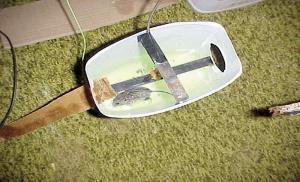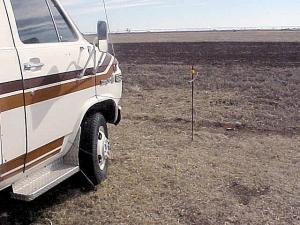2003 - Volume #27, Issue #6, Page #17
[ Sample Stories From This Issue | List of All Stories In This Issue | Print this story
| Read this issue]
Mouse Trap Powered By Electric Fence Charger
 |
 |
According to Lamb, a single 12-volt or 110-volt fence charger can be used to operate any number of traps over an entire farm and can even be used inside vehicles such as combines, tractors, pickups, and motorhomes. "On my farm I have two traps inside my shop, one inside my pickup, and another one inside my motorhome. All the traps are hooked up to an electric fence that surrounds my pasture. "
What makes the idea work so well, says Lamb, is that fence chargers operate at high voltage - 3,000 to 9,000 depending on the model - which is more than enough to kill most mice. If the mouse doesn't die right away it will be stunned and fall into water at the bottom of his traps and immediately drown. And though they operate at high voltage, electric fence chargers draw very little amperage. "Fence chargers barely use up enough electricity to change your meter reading," notes Lamb.
His patent pending traps are made from 2 1/2-gal. chemical jugs cut down to 8 in. high. A 2-in. high hole is cut into each end of the container, about 6 in. off the bottom. A ramp - made out of cardboard, wood or even rocks - leads up to each hole. He then pop rivets a pair of 1-in. wide metal straps inside the container. One strap runs lengthwise about 3 in. above the bottom of the container, while the other strap runs across and about 5 in. above it. A ground wire leads from the bottom strap to the fence charger. The positive wire is attached to a small metal screen enclosure that contains the bait and hangs about 3 in. below the top strap. Water fills the container to a depth of 1 or 2 in.
The mouse enters the trap on the cardboard "ramp" and then follows the grounded strap to the bait. As it reaches for the bait, the mouse contacts the screen, gets electrocuted, and falls into the water.
"It's a simple idea but it works fantastic," says Lamb. "I've caught as many as 22 mice in a single trap in one night. I've caught more than 400 mice since I installed my first trap last year. The container can be any shape or size. I've used 1 gal. anti-freeze jugs and 5-gal. pails.
"The mouse usually gets electrocuted before it ever touches the bait, so the bait always stays fresh. You never have to reset the trap. The only maintenance is to remove the mice from the water. I think it's a practical idea even if you don't have livestock and have no need for an electric fence charger. You can buy a battery-operated charger for less than $40. Or you can install a 110-volt model and use it to operate traps inside your buildings, then run a wire from the buildings to your vehicles outside."
Lamb runs wires all over his farmstead, elevating it up over the driveway on poles so it's out of the way.
"I put an antiseptic in the water, such as lysol or household ammonia, to kill any bacteria carried by the mouse, and to keep the mouse from smelling for several days. During the winter you can put antifreeze in the water."
Lamb has already sold more than 100 traps in his local area. He's now looking for a manufacturer and is also designing a trap for rats.
Contact: FARM SHOW Followup, Keith Lamb, Box 340, Gruver, Texas 79040 (ph 806 733-2893).

Click here to download page story appeared in.

Click here to read entire issue
To read the rest of this story, download this issue below or click here to register with your account number.




